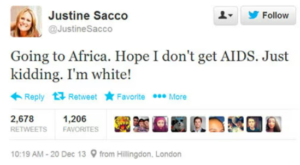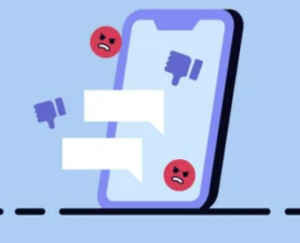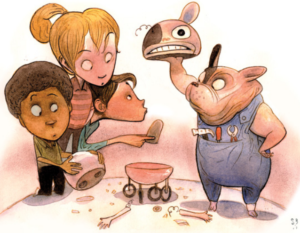
Last week I explored the incident revolving around Justine Sacco and how a post that she intended to poke fun at America’s lack in Third World education became a case of “mistaken racism” that led the world on a hate train, shaming Justine with no remorse.
Cyber-Shaming and Fake News
As a result of Justine Sacco’s Tweet, she faced extreme, global, cyber-shaming. Cyber-shaming is a form of cyberbullying where it is generally more acceptable to “bully” someone. Justine, for example, faced threats and wishes for harm, such as getting AIDS, physically harmed, death, etc. In person, this would be seen as harassment, and would typically be dealt with professionally and with law enforcement. However, because Justine’s Tweet was posted online, with no way for her to defend herself against the public, she was globally shamed for something she had no ill intentions of.
 Many people have a bad habit of jumping to conclusions and assuming the worst in people. In the online community, this becomes much worse due to how easy it is to type out a thought and hit “send.” Often, people get caught on a hate-train, or form conclusions about things without properly thinking about it. This is where fake news comes into play. I was reading up on examples of fake news and came across a TikTok post that said Disney World was going to lower the drinking age to 18. The source, a random TikToker, was posting a clickbait video, aiming to get a flood of comments and shares discrediting it. However, many people believed it, and the post was sent to Facebook and other sources to share the “good news.”
Many people have a bad habit of jumping to conclusions and assuming the worst in people. In the online community, this becomes much worse due to how easy it is to type out a thought and hit “send.” Often, people get caught on a hate-train, or form conclusions about things without properly thinking about it. This is where fake news comes into play. I was reading up on examples of fake news and came across a TikTok post that said Disney World was going to lower the drinking age to 18. The source, a random TikToker, was posting a clickbait video, aiming to get a flood of comments and shares discrediting it. However, many people believed it, and the post was sent to Facebook and other sources to share the “good news.”
Fake news is everywhere. It’s can be unharmful and as simple as writing a gag post saying that “Taylor Swift loves mangos” but you don’t know if your information is true. However, it’s harmful fake news, and in relation disinformation, that has the world worried for internet users. This article explains how disinformation can be used to cover up certain subjects by making something unimportant or irrelevant seem important, such as bringing up “Clinton conspiracy theories more than Trump’s alleged sexual assaults and ties to Russia.” In this scenario, a publisher can spread disinformation and hide more pressing issues.
Teaching Students how to Spot Fake News

To help my students begin to learn how to tell the difference in fake vs real news, I could have them attempt harmless game quizzes like Spot The Troll. Of course, I would use this if I were teaching a lesson about fake news and how to spot it. But students use technology all the time and in different ways, so how do I protect them and help them build digital literacy?
How is this relevant for students? Well, I want to teach elementary education, more-so grade 3-5. Let’s say I assign my fifth graders a science project/presentation where they research an animal and present to the class. One of the students might come across the Tree Octopus page, a made-up animal website created to bring awareness to fake news. Now, we would think children could tell that the page is fake – an octopus is a sea animal, it can’t live in trees! However, some students are more gullible than others, and this small, harmless bit of disinformation can show how susceptible young students are to fake news.
 The Smell Test article describes how we can actively teach students to analyze news authenticity. This practice can be incorporates throughout different subject areas and alongside the NCTE framework goals. The Smell Test suggest to teach one lesson of branded content, brushing of on fake news, authenticity, disinformation and more. Provide the students with a list of examples and have them rank which ones are harmless, real, or over-the-top. When they’ve completed the lesson, a teacher can incorporate practices throughout different lessons. Like before, a science lesson could include talking about the tree octopus, and a social studies lesson could look into conspiracies vs fact regarding WW2 or civil rights movements. A way I think to incorporate it is through the books the students read. Having them read a book where the narrator is unreliable or there is a character widely-spreading disinformation could show the students a broader range of how fake news comes into play in several aspects of life.
The Smell Test article describes how we can actively teach students to analyze news authenticity. This practice can be incorporates throughout different subject areas and alongside the NCTE framework goals. The Smell Test suggest to teach one lesson of branded content, brushing of on fake news, authenticity, disinformation and more. Provide the students with a list of examples and have them rank which ones are harmless, real, or over-the-top. When they’ve completed the lesson, a teacher can incorporate practices throughout different lessons. Like before, a science lesson could include talking about the tree octopus, and a social studies lesson could look into conspiracies vs fact regarding WW2 or civil rights movements. A way I think to incorporate it is through the books the students read. Having them read a book where the narrator is unreliable or there is a character widely-spreading disinformation could show the students a broader range of how fake news comes into play in several aspects of life.
Leave a Reply